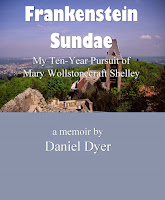Anyway, Mary’s
decision is interesting—to set a scene in her novel Lodore at Niagara Falls, which, of course, she
had never seen. She would never visit America—though, as I’ve written earlier,
she came close (well, not too close)
when the amazing social reformer Fanny Wright, in the fall of 1828, invited
Mary to join her in Tennessee to try to make a go of it at Nashoba, her
settlement near Memphis (where, coincidentally—very coincidentally—Joyce and I spent the second night of our
honeymoon journey in December 1969, our drive from Akron, Ohio, where we were
married, to New Orleans, a destination we’d picked because neither of us had
ever been there)—Nashoba, where Fanny Wright was trying to set up a model
settlement, a place to train former slaves for productive lives on the
“outside.” The experiment failed (for reasons I discussed earlier), but that,
as far as we know, was the only offer Mary entertained (and rejected) concerning
a visit to the United States.
So … what
did she know about Niagara Falls? And when did she know it? (To steal from Sen.
Sam Ervin in the 1973 Senate Watergate hearings.)
Even in
Mary’s day the Falls was a popular tourist destination—though, of course, it
was a much more rigorous and stressful journey than it is today—although I can
testify that traffic on I-90 and I-190 in and around Buffalo, New York, can be
what we now call A Major Pain. Slow, tedious, even a bit worrisome when you get
to the international border with Canada. (What
will they ask me? Am I busted?—foolish worries for a Good Little Boy like
me, but still ….)
So Mary had
surely read about the Falls somewhere—or seen the many images available in
books and newspapers and periodicals. But there is a more interesting possibility, a possibility involving her old
friend and sometime-annoyance Edward John Trelawny—the man who’d endeared
himself to Bysshe and Byron in that fatal summer of 1822, the man who would
travel with Byron to Greece (where Bryon died of illness in Missolonghi, April
19, 1824), the man who, with Mary’s help, published a book of rarely accurate
memoirs, the man who would write repeatedly about his association with the
Shelley-Byron circle (and create ever more extravagant exaggerations), the man
who, in 1833, visited Niagara Falls, a man who was still, during the early
1830s, writing to Mary and her step-sister, Claire Clairmont, the young woman
who had fled with Mary and Bysshe when they eloped in 1814.


No comments:
Post a Comment